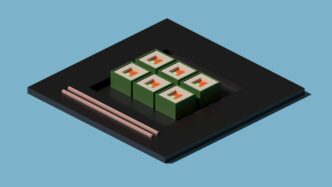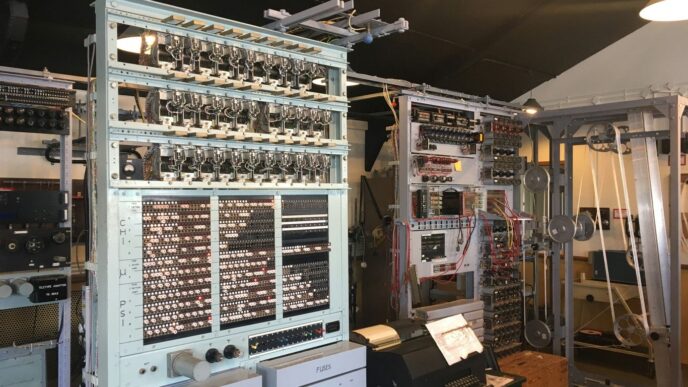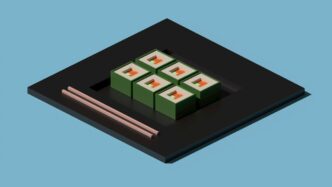So, you’re curious about the price tag on Google’s quantum computer? It’s a bit more complicated than just looking up a model number. We’re talking about a massive investment in research, development, and building some seriously advanced hardware. It’s not something you’ll find on Amazon anytime soon, but the costs involved are pretty eye-opening. Let’s break down what goes into the google quantum computer cost and what it means for the future.
Key Takeaways
- Google is investing billions into quantum computing, aiming for a million qubits, showing a long-term commitment to the technology.
- Early commercial quantum computers, like those from D-Wave, had price tags in the millions, highlighting the high cost of initial development.
- Google’s Sycamore and Willow chips represent milestones in qubit development and error correction, pushing the boundaries of what’s possible.
- Achieving ‘quantum advantage’ or ‘supremacy’ is a big deal, but the real value lies in practical applications like drug discovery and materials science.
- While a fully commercial quantum computer is still a ways off, advancements in error correction and algorithms are paving the path to more reliable and useful quantum systems.
Understanding The Google Quantum Computer Cost Landscape
So, you’re curious about what it costs to get Google into the quantum computing game, huh? It’s not exactly like buying a new laptop, that’s for sure. We’re talking about some serious investment here, stretching across a few different areas. It’s a whole landscape, really, with different pieces contributing to the overall picture.
The Ambitious Vision Behind Google’s Quantum Endeavors
Google isn’t just dabbling; they’ve got a big plan. They’re aiming for a million qubits down the line, which is a massive number. To get there, they’re pouring billions into research and development. They’ve even set up a fancy quantum AI campus in Santa Barbara. This isn’t just about building a machine; it’s about pushing the boundaries of what’s possible. They’ve already shown what their quantum computers can do, like simulating a chemical reaction back in 2020. This kind of simulation could eventually help design better batteries or even new drugs, saving tons of time and money on physical prototypes. It’s a long road, but the potential payoff is huge.
Early Commercial Ventures in Quantum Computing
While Google is a major player, they aren’t the only ones trying to make quantum computing a reality. Back in 2017, a Canadian company called D-Wave put a quantum computer on the market for about $15 million. More recently, there have been claims of smaller, more affordable desktop quantum computers, some even under $5,000. Even though these machines aren’t solving major real-world problems just yet, some big organizations are already buying in. The UK’s Ministry of Defence got one in 2017, and big banks like Goldman Sachs and Citigroup have put money into quantum companies. It shows there’s a belief in the future, even in these early stages.
The Evolving Definition of Quantum Advantage
What does it even mean for a quantum computer to be ‘better’ than a regular one? That’s where "quantum advantage" comes in, and it’s a bit of a moving target. Google made a big splash in 2019 claiming "quantum supremacy," saying their Sycamore processor did a calculation in 200 seconds that would take a supercomputer 10,000 years. Pretty wild, right? The catch was, the calculation itself wasn’t all that useful – it just spat out random numbers. Plus, rivals like IBM argued a supercomputer could do it much faster than Google claimed. More recently, in October 2025, Google announced results from their Willow processor, claiming a "verifiable" case where a quantum computer was faster than a classical one. This time, they’re focusing on reproducibility, which is a step forward from those earlier, less concrete claims. It seems the definition of what counts as a real advantage is still being figured out, especially when it comes to practical applications. Developing a custom quantum processor chip itself can cost anywhere from $20 million to $100 million, making it the most expensive part of the whole setup [4d8f].
Google’s Quantum Hardware And Its Cost Implications
When we talk about the cost of quantum computing, it’s not just about the price tag of a single machine. It’s a whole ecosystem of development, hardware, and the sheer brainpower needed to make it all work. Google’s been investing heavily here, and their hardware is a big part of that story.
The Sycamore Processor: A Milestone In Qubit Development
Remember Sycamore? That was Google’s big quantum processor that made waves a few years back. It had 53 working qubits, which was a pretty big deal at the time. The idea behind Sycamore was to show that quantum computers could do something useful, something that regular computers would struggle with. They used it to simulate a chemical reaction, which sounds a bit abstract, but it hints at how this tech could help design new drugs or create better materials down the line. It was a step, for sure, but still a long way from solving everyday problems. Think of it like building the first car engine – impressive, but not exactly ready for a cross-country road trip.
The Willow Chip: Advancements In Error Correction
More recently, Google introduced the Willow chip. The big challenge with quantum computers is ‘noise’ – basically, errors that mess up calculations. It’s like trying to have a conversation in a really loud room; the message gets garbled. A lot of work is going into ‘error correction’ to clean up these signals. Willow is significant because Google showed they could actually reduce errors using a technique called the surface code. This is a pretty tough hurdle to clear. While Willow’s basic hardware might not be drastically different from other systems out there, Google seems to have found a way to make error correction actually help, rather than make things worse. This is a key piece of the puzzle for building more reliable quantum computers.
Future Hardware Roadmaps And Investment
Google isn’t just building chips; they’re building a whole future. They’ve got this massive goal of reaching a million qubits. That’s a huge number, and it means a ton of ongoing research and development. They’ve even set up dedicated quantum AI campuses. This isn’t cheap. We’re talking billions of dollars poured into this over the next decade. It’s a long game, and the hardware is just one piece. The investment reflects the belief that quantum computing will eventually change industries, but getting there requires serious, sustained funding for hardware advancements, software, and the people who can actually make it all happen.
The True Cost Of Quantum Computing Research
So, how much does all this quantum wizardry actually cost? It’s not exactly pocket change. We’re talking about billions of dollars being poured into this field, and that’s just the beginning. Google, for instance, has put a massive amount of money into developing its quantum tech, even building a whole fancy campus dedicated to quantum AI in Santa Barbara. Their big goal? A million qubits. Yeah, a million. It sounds like science fiction, but they seem pretty serious about it.
Billions Invested In Quantum Technology Development
This isn’t just Google, though. Lots of companies and even governments are throwing money at quantum computing. Think about it: building these machines requires super specialized equipment, incredibly cold temperatures (like, colder than outer space), and a whole team of brilliant minds working on the really tricky problems. It’s a huge undertaking. Early on, companies like D-Wave were selling machines for $15 million, and that was years ago when the tech was even less developed. Now, with more advanced systems and ambitious goals, the investment figures are only going up.
The Role Of Quantum AI Campuses
These dedicated campuses aren’t just for show. They’re hubs where researchers can collaborate, experiment, and push the boundaries. Imagine a place filled with cutting-edge labs, specialized clean rooms, and all the gear needed to build and test these sensitive quantum processors. It’s like building a space shuttle – you need a massive, specialized facility. Google’s Santa Barbara campus is a prime example, designed to bring together different aspects of quantum research, from hardware to the AI that will eventually run on it. This kind of infrastructure is a significant part of the overall cost, creating an environment where breakthroughs can happen.
The Long Road To A Million Qubits
Getting to that million-qubit mark is a marathon, not a sprint. It involves tackling some seriously tough engineering challenges. For example, keeping qubits stable and preventing errors is a constant battle. Noise, as they call it, can mess up calculations. Companies are working on clever ways to fix these errors, like using something called ‘surface codes’. But even these fixes have their own issues, and researchers are still figuring out the best approaches. It’s a step-by-step process, with each advancement building on the last. The journey to a million qubits means overcoming hurdles in:
- Qubit Stability: Making sure the quantum bits stay in their quantum state long enough to do useful work.
- Error Correction: Developing sophisticated methods to detect and fix errors introduced by noise and environmental interference.
- Scalability: Figuring out how to build and connect millions of qubits without them interfering with each other.
- Control Systems: Creating precise ways to manipulate and read out the state of each individual qubit.
It’s a complex puzzle, and the cost reflects the sheer difficulty and the long-term commitment required to solve it.
Decoding Quantum Supremacy And Its Value
Defining Quantum Supremacy In Practical Terms
So, what’s this "quantum supremacy" thing everyone’s talking about? Basically, it’s the moment a quantum computer can do a specific job that even the most powerful regular (classical) computers just can’t handle, or would take an absurdly long time to do. Think of it like a race: classical computers are like really fast cars, but quantum computers are like spaceships. For certain types of problems, the spaceship just leaves the car in the dust. Google made a big splash back in 2019 claiming they’d hit this mark. They said their quantum computer, Sycamore, crunched a problem in about 200 seconds that would take a supercomputer 10,000 years. Now, the problem itself wasn’t exactly solving world hunger – it was more like a complex math puzzle that spat out random numbers. But the point was to show off the sheer speed and potential power. It was a huge milestone, showing that quantum computers weren’t just theoretical ideas anymore.
The Debate Over Quantum Calculation Speed
That 2019 announcement, though? It wasn’t without its critics. Right after Google’s big reveal, folks over at IBM chimed in, saying that with a bit of clever programming, a supercomputer could actually solve that same problem in just a couple of days, not 10,000 years. And then, a few years later, researchers in China managed to do it even faster using regular processors. This whole back-and-forth highlights a key point: defining and proving "quantum supremacy" isn’t as straightforward as it sounds. It’s not just about raw speed; it’s about the type of problem and how efficiently it’s solved. The goalposts can shift as both quantum and classical computing technologies improve. It’s a bit like arguing about who’s faster – a drag racer or a rally car driver – it really depends on the track.
Real-World Applications Versus Theoretical Milestones
While hitting "quantum supremacy" is a cool technical achievement, the real excitement comes from what these machines could do for us. Right now, many of the demonstrations are more like scientific experiments than practical tools. For instance, Google’s recent "Quantum Echoes" algorithm, running on their Willow chip, showed incredible precision and speed, completing calculations 13,000 times faster than a top supercomputer. What’s neat about this one is that its results are verifiable – meaning you can check and be sure the answer is correct, which is a big deal. This is a step towards solving actual problems, like designing new drugs or materials, or making artificial intelligence smarter. But we’re not quite there yet. For everyday computing tasks or even many complex scientific ones, your laptop or a standard server is still the way to go. The truly game-changing applications are still on the horizon, waiting for quantum computers to become more powerful, stable, and accessible.
The Future Of Quantum Computing And Its Economic Impact
So, what’s next for quantum computing? It’s a big question, and honestly, nobody has all the answers yet. But we can see some pretty exciting possibilities starting to take shape.
Potential Applications In Drug Discovery And Materials Science
Think about creating new medicines or designing super-strong, lightweight materials. Right now, figuring out how molecules interact or how materials behave at a tiny level is incredibly tough for even the best regular computers. Quantum computers, though, are built to handle these kinds of complex simulations. This could mean faster development of life-saving drugs and the creation of materials we can only dream of today. Imagine designing a better battery for your phone or a more efficient solar panel – that’s the kind of stuff we’re talking about.
The Intersection Of Quantum Computing And Artificial Intelligence
This is another area where things get really interesting. Artificial intelligence, or AI, is already changing a lot of how we do things. But AI systems are currently limited by the power of the computers they run on. Quantum computers could give AI a massive boost. They could help AI process huge amounts of data much faster and more accurately. This could lead to smarter AI that can solve problems we haven’t even thought of yet. We’re already seeing terms like "Quantum AI" pop up, suggesting a future where these two powerful technologies work hand-in-hand.
The Path To Commercially Viable Quantum Solutions
Getting from where we are now to a point where quantum computers are used for everyday business tasks is a long road. It’s not just about building more powerful machines; it’s also about making them reliable and easy to use. Companies are investing billions, and while we’ve seen some impressive milestones, like Google’s work on error correction with their Willow chip, there’s still a lot of work to do. It’s a bit like the early days of classical computers – they were huge, expensive, and not very practical for most people. But look at them now!
Here’s a quick look at some of the steps involved:
- Improving Hardware: Making qubits more stable and reducing errors is key.
- Developing Algorithms: Creating new ways for quantum computers to solve problems.
- Building Software: Making it easier for people to program and use quantum computers.
- Finding Practical Problems: Identifying specific tasks where quantum computers truly outperform regular ones.
While some companies have already put quantum computers on the market, with prices ranging from millions of dollars to, in some experimental cases, under $5000, these are still early days. The real economic impact will come when these machines can tackle complex, real-world challenges that are currently out of reach for classical computing.
Navigating The Complexities Of Quantum Computation
So, you’ve heard about quantum computers doing amazing things, right? But what actually makes them tick? It’s not quite like your laptop. The whole idea hinges on some pretty wild physics.
Understanding Qubits and Superposition
Forget the simple on-or-off bits in your phone. Quantum computers use something called qubits. These little guys are special because they can be a 0, a 1, or, get this, both at the same time. This is called superposition. It’s like a coin spinning in the air before it lands – it’s neither heads nor tails, but a mix of both possibilities. This ability to hold multiple states simultaneously is what gives quantum computers their potential power. It’s a big departure from how classical computers work, which is why quantum computing is so different.
The Challenge of Noise in Quantum Systems
Now, here’s where things get tricky. Qubits are super sensitive. They’re easily messed up by their surroundings – think tiny vibrations, temperature changes, or even stray electromagnetic fields. This interference is called ‘noise,’ and it can corrupt the delicate quantum states. Imagine trying to have a quiet conversation in the middle of a rock concert; that’s kind of what it’s like for qubits. Scientists are working hard on ways to shield these qubits and correct the errors that noise causes. It’s a bit like trying to keep a perfectly balanced stack of Jenga blocks from toppling over.
The Importance of Verifiable Quantum Calculations
Because qubits are so fragile and prone to errors, it’s really important to be able to check if a quantum computer’s answer is actually correct. This isn’t always straightforward. You can’t just run the calculation again and expect the same result, because the act of measuring a qubit can change its state. So, researchers have to come up with clever ways to verify the output. This often involves comparing the quantum computer’s results to what classical computers can predict, or designing specific tests that can confirm the quantum computation was performed as intended. It’s a bit like double-checking your math homework, but with much higher stakes and more complicated equations.
So, What’s the Bottom Line?
Look, figuring out the exact price tag for Google’s quantum computer is a bit like trying to nail jelly to a wall right now. It’s still super early days, and the tech is changing fast. We’ve seen some early commercial machines go for millions, while others are trying to make them cheaper. Google’s pouring a ton of money into this, aiming for a million qubits, which is a huge goal. They’ve had some wins, like simulating chemical reactions, which hints at future uses in medicine or materials. But remember, these machines aren’t ready for your everyday tasks yet. It’s a long road, and while Google’s recent work with the ‘Quantum Echoes’ algorithm shows real progress in getting verifiable results, we’re still a ways off from having a quantum computer that can solve all our problems. It’s exciting, for sure, but don’t expect to buy one next week.
Frequently Asked Questions
How much money is Google spending on quantum computers?
Google is putting a lot of money into quantum computers, planning to spend billions over the next ten years. They’ve even built a special research center for it. Their big goal is to create a quantum computer with a million tiny parts called qubits.
What’s the difference between a regular computer and a quantum computer?
Regular computers use bits that are either a 0 or a 1. Quantum computers use ‘qubits’ which can be a 0, a 1, or both at the same time! This ‘superposition’ lets them explore many possibilities at once, making them potentially much faster for certain problems.
What is ‘quantum supremacy’?
Quantum supremacy is when a quantum computer can do a specific task that even the most powerful regular computers can’t do, or would take an impossibly long time to do. Google claimed they reached this point, but there’s still debate about how useful that specific task was.
Can quantum computers be used for everyday things yet?
Not really. Quantum computers are still very new and tricky to use. They’re mostly used for research and solving very specific, complex problems that regular computers struggle with, like designing new medicines or materials.
What are some cool things quantum computers might do in the future?
They could help discover new medicines, create amazing new materials for things like better batteries, and maybe even make artificial intelligence much smarter. They’re also good at breaking some types of secret codes, which is why people are also working on new kinds of codes that quantum computers can’t break.
Is Google’s new ‘Willow’ chip a big deal?
Yes, the Willow chip is important because it’s better at fixing errors that happen in quantum computers. This is a big step towards making quantum computers more reliable and useful for solving real-world problems, even though the hardware itself isn’t drastically different from others.














